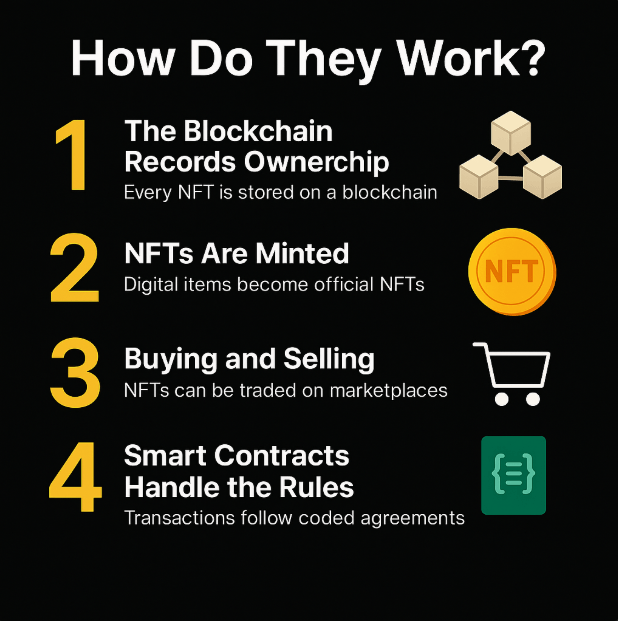How NFTs Actually Work
NFTs function using blockchain technology, the same infrastructure that underpins cryptocurrencies. Here’s the step-by-step process:
Step 1: Blockchain Storage
Each NFT resides on a blockchain, which acts as a public, unalterable record tracking ownership. Think of it as a secure, transparent digital ledger that anyone can verify but no one can tamper with.
Step 2: Minting Process
When a digital file is transformed into an NFT, it undergoes “minting.” This process takes the digital asset and, through smart contract software, associates it with identifying information, making it official and ready for purchase, sale, or exchange.
Step 3: Cryptocurrency Transactions
NFTs are typically bought and sold using cryptocurrency, most commonly Ethereum. Once a purchase is made, the blockchain updates automatically to reflect the new owner.
Step 4: Smart Contract Rules
Many NFTs incorporate smart contracts—software code that establishes rules governing the NFT. These rules can ensure the original creator receives a percentage of future sales, for example, creating ongoing royalties.
Why NFTs Have Surged in Popularity
What Makes NFTs Valuable?
Several factors drive NFT adoption and value:
- True Digital Ownership: NFTs provide verifiable digital receipts confirming ownership of digital assets
- Creator Empowerment: Artists and musicians can sell work directly to fans, eliminating intermediaries and securing royalties on resales
- Gaming Innovation: NFTs enable trading in-game items across different platforms, fostering dynamic gaming economies
- Digital Collectibles: Trading cards, sports highlights, and memes find new life as NFTs, offering collecting excitement in the digital realm
- Crypto Ecosystem Integration: NFTs present novel investment avenues within the broader digital economy
Can I Create My Own NFT?
Yes, anyone can mint an NFT on a supporting marketplace, provided they have a crypto wallet and some cryptocurrency to cover associated fees (called “gas fees”). The process typically takes minutes and requires no coding knowledge.
Do NFTs Always Increase in Value?
No, prices are dictated by demand and rarity, making them a potentially risky investment. Like traditional art or collectibles, NFT values can fluctuate dramatically based on market trends, creator reputation, and collector interest.
Are NFTs Only Connected to Ethereum?
While Ethereum is widely used, other blockchains like Solana and Polygon are designed for NFT scalability, offering lower costs, reduced environmental impact, and enhanced speed. Flow and Tezos are also gaining traction.
Can NFTs Be Stolen?
Yes, theft can occur through unauthorized wallet access or phishing scams, underscoring the importance of security. Always use hardware wallets for valuable NFTs, enable two-factor authentication, and verify URLs before connecting your wallet.
What Industries Outside Art and Gaming Use NFTs?
Industries such as real estate, ticketing, and fashion are exploring NFTs for authentication and security. Universities are issuing NFT diplomas, musicians are selling concert tickets as NFTs, and luxury brands use them to prove authenticity.
🏪 Popular NFT Marketplaces
- OpenSea: The largest marketplace supporting a wide range of digital assets across multiple blockchains
- Zora: A platform geared towards creators for launching NFT collections with minimal fees
- Rarible: A decentralized, community-driven platform with governance tokens
- Magic Eden: Popular platform on Solana known for fast and low-fee transactions
- Blur: Professional trading platform with advanced features for serious collectors
💎 Notable Real-World NFT Examples
- Beeple’s “Everydays”: Digital artwork sold for $69 million at Christie’s auction
- Kings of Leon: First major band to release an album as an NFT
- Steph Curry: Launched custom sneaker NFTs for fans
- Snoop Dogg: Created music NFTs and a virtual mansion in the metaverse
- Bored Ape Yacht Club: Profile picture NFTs that became status symbols
⚠️ Essential Considerations Before Buying NFTs
- Uniqueness: NFTs are distinct from standard cryptocurrencies—they’re unique, unlike fungible coins like Bitcoin
- Market Volatility: Values fluctuate significantly based on demand; prices can crash overnight
- Wallet Required: A crypto wallet is indispensable for purchasing and trading NFTs
- Scam Awareness: Be vigilant about scams and counterfeit NFTs; always verify blockchain history
- Environmental Impact: Some blockchains consume significant energy, though newer chains are more efficient
- Legal Uncertainty: NFT ownership doesn’t always equal copyright ownership of the underlying asset
NFTs vs. Regular Digital Files
| Feature | Regular Digital File | NFT |
|---|---|---|
| Ownership | Anyone can copy or download it | Blockchain proves who owns it |
| Rarity | Infinite copies exist | Each one is unique and traceable |
| Transfer | Sent like an email attachment | Bought and sold securely on marketplaces |
| Value | Usually little to no resale value | Can gain or lose value like a collectible |
🚀 Getting Started with NFTs
Now equipped with NFT knowledge, you can take these first steps:
- Set Up a Wallet: Download MetaMask or Coinbase Wallet
- Fund Your Wallet: Purchase ETH or SOL from an exchange
- Explore Marketplaces: Browse OpenSea or Magic Eden to understand pricing
- Research Projects: Check roadmaps, team credentials, and community engagement
- Start Small: Make your first purchase with money you can afford to lose
Explore the NFT Ecosystem
NFTs are transforming the concept of digital ownership. Whether you’re a creator looking to monetize your work or a collector exploring digital assets, understanding how NFTs work is the first step toward participating in this revolutionary technology.
Key Takeaway: NFTs represent a paradigm shift in how we think about digital ownership and scarcity. While the technology offers exciting possibilities for creators and collectors, it’s essential to approach NFT investments with caution, thorough research, and an understanding of the risks involved.


